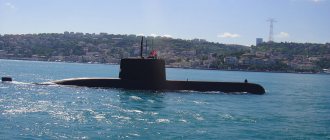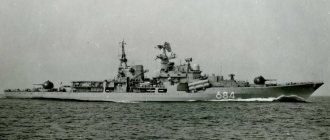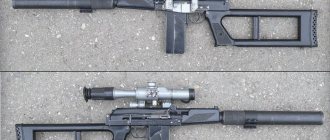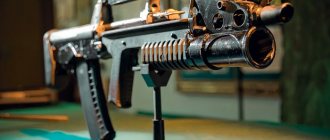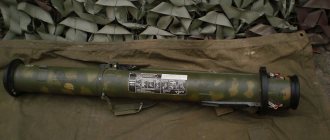A couple of years ago, the international exhibition LIMA took place on the Malaysian island of Langkawi. As part of this event, the St. Petersburg design bureau "Malachite" presented to the professional community the small submarine "Piranha" armed with hypersonic cruise missiles "Caliber". And on the sidelines of a significant event for submarine engineers, Nikolai Novoselov, deputy general director of Malachite, lamented that, for a mysterious reason, the brainchild of the design bureau for some reason did not find a market in the Fatherland. The project was under threat, since no one was going to squander defense secrets abroad.
© malachite-spb.ru Silent underwater killers, products of Project 865 “Piranha”, were appreciated back in the days of the USSR Navy.
However, now everything has changed...
Silent underwater killers, products of Project 865 “Piranha”, were appreciated back in the days of the USSR Navy. Unfortunately, their birth occurred in perhaps the most unfavorable era for the Russian defense industry - 1989-1992. The designers, at the cost of exorbitant efforts, managed to lay down and bring to delivery to the customer two conventional-type submarines equipped with a diesel-electric power plant. Unfortunately, the project did not have time to go into series. Everything was limited to two prototypes - MS-520 and MS-521. The latter was found suitable in all respects. Its transfer to the fleet took place at the end of 1990.
According to the designers' plans, small underwater craft were intended to operate at shallow depths and even in river waters. Submarines were also suitable for sabotage activities, when directly entering the raid of the naval bases of a potential enemy. Nevertheless, the Piranhas remained in service for only a short time. In 1999, only 9 years after the end of sea trials, they were sold for... scrap metal.
© Still from the film
“Piranha” made its way into the film “Peculiarities of National Fishing.”
But in 1998, one of the boats became a movie star. As if fighting against the general oblivion and cold indifference to the fleet characteristic of the Yeltsin era, one of the “piranhas” made its way into the film “Peculiarities of National Fishing”, immortalizing itself in unforgettable footage.
Taking into account the above, it is easy to understand the delight of engineers who are not indifferent to maritime affairs when, in 2022, it was decided to allocate funds from the budget for the development of a project so needed by the Navy - a new generation of mini-class submarines. So the invention received a second life in the new Russia. Two submarines laid down on the stocks in St. Petersburg received letter-numeric designations and personal names, respectively: P 650 and P 750 - “Super-Piranha 1” and “Super-Piranha 2”. The most important thing is that the company managed to save all the working documentation and finalize the project to the modern level in the shortest possible time. In this regard, it becomes clear that the submarines will not go through a long process of complex testing, but will quickly go into production.
© mil.ru
Anti-ship missile "Caliber".
Little Russians can handle an aircraft carrier
The performance characteristics of “super-piranhas” with a tiny displacement of only 730 tons make them comparable in their formidable power and maneuverability to nuclear-powered hunter submarines with a displacement of 1.2 thousand - 12 thousand tons. In addition, the presence of “Caliber” or “Onyx” on board will allow the P 650 to claim such a trophy as... an aircraft carrier. By the way, in addition to four missiles dormant in vertical launch tubes, the “baby” can also boast of four 533-mm torpedoes. The declared working diving depth is also impressive - up to 300 meters. And the cruising range allows you to make a real hike - from 1,200 to 1,500 miles with an anaerobic power plant, which gives underwater autonomy up to three weeks.
By the way, the P 750 has already increased its range to 2,000 nautical miles, although, of course, its displacement is different - about 950 tons, which is approximately 200 tons more than its toothy younger sister. In addition to the declared standard weapons, common for both types, the second Super-Piranha is capable of taking on board an additional 12 depth mines.
© mil.ru
Anti-ship missile "Zircon".
If we conduct a thoughtful analysis of the characteristics, it turns out that the need for colossal submarines may disappear, since our “predatory fish” can theoretically cope with the operational and tactical tasks of the class of nuclear submarine cruiser.
Reference
The ability to retrofit “super-piranhas” with Zircon missiles makes their weapons virtually invulnerable to NATO air defenses. In this case, our missile, even if it does not carry a warhead, will only have enough kinetic energy to turn the hull of a floating airfield into a colander.
It seems that Grand Admiral of Hitler’s submarine, Dönitz, was right when he predicted the abandonment of Tirpitz-class super-battleships in favor of underwater killers.
The creators of the formidable miracle did not forget about the sabotage component of the boat. It allows the command to send along with the team six combat swimmers with full equipment and standard weapons.
"Piranha": a submarine for saboteurs and surprise attacks
At the Malaysian international exhibition of weapons and military equipment LIMA 2022, the St. Petersburg Marine Engineering Bureau "Malachite" presented small submarines of the "Piranha" type, which are armed with the most modern missile weapons.
The family of mini-submarines includes, in particular, the Piranha-450, Piranha-650E, and Piranha-950 boats. Submarines can carry torpedoes, missiles and mines. Some submarines have an airlock chamber, which allows the landing of combat swimmers.
Small submarines with a displacement of tens to several hundred tons are effective in the coastal sea zone, including river mouths, in shallow waters, and in rugged coastline conditions. In recent years, a number of countries in Asia, Africa and Latin America have shown interest in them.
Small submarines were most actively built in the Soviet Union in the 30s and 40s. During this period, the Navy received more than 150 Malyutka-class submarines with a displacement of 200 to 250 tons, a length of up to 40 meters and a working depth of 50 meters. At the same time, the crew was quite respectable - 36 people. In terms of firepower, the “Malyutka” can be compared to a “double-barreled gun without a bandoleer” - there were two bow torpedo tubes without additional torpedoes. However, during the war, the Malyutki sank 10 enemy warships and 61 ships.
Our babies are also invisible
Well, and finally, an important detail related to the stealth “invisibility” mode. The acoustic signature of the engine of such a boat practically merges with the natural sea background.
Reference
The highlight of the stealthiness of the new boats lies in the latest AGP (anti-hydrolocation coating), which should be made either according to the Molniya project, or even from piezocomposite plates (active AGP), distorting the ultrasonic pulses of the enemy radar using the artificial intelligence of the system.
Do not forget that the basic documentation allows you to equip the “super-Piranha” with a completely titanium case (the technology of Project 661 - “Goldfish” is used here). In addition to the speed increasing from such a technical solution, the problem of combating corrosion, which is inescapable for the classical fleet, will also be solved.
© malachite-spb.ru
Small coastal submarines.
Design
The Project 865 SMPL body was made of titanium alloy and designed for a immersion depth of 200 meters. Full underwater speed reached 6.7 knots, surface speed - 6 knots. The cruising range underwater at economic speed (4 knots) reached 260 miles, and on the surface - 1000 miles.
The central post housed the operator's console, instrument racks and information display facilities, as well as controls for the main systems and devices. A battery pit was located under the deck deck of the central post. Closer to the nose from the operator's console there was an entrance hatch, a periscope, and a shaft for the retractable device of the radar complex. The central post was limited by a bow spherical bulkhead, which had an entrance hatch to the airlock chamber. On the bow bulkhead there was a porthole for monitoring the work of divers and a gateway for transferring objects from the CPU to the chamber. There were also control devices for the divers' locking system.
The central post was separated from the electromechanical compartment by a flat aft bulkhead with a gas-tight door. In the electromechanical compartment, on a shock-absorbing platform, disconnected from the durable hull, there was a 160 kW diesel generator, a 60 kW DC propulsion motor, pumps, fans, a compressor and other equipment. Thanks to a double-stage shock absorption system combined with noise-absorbing coatings on the hull structures, the Project 865 submarine had a minimal acoustic field. The electromechanical compartment was visited during the trip only to check the condition of the technical equipment. The screw, placed in a rotating ring attachment, also served as a vertical rudder.
Our response to the Americans and Japanese
Initially, small submarines were intended for coastal purposes in the immediate vicinity of our coastline. But, in principle, taking into account simple calculations, we can safely say that six combat units of this class are enough for reliable control over the entire Black Sea.
In addition, Russia now technically has the ability to expand its margin of strategic initiative in the Sea of Okhotsk region. Today, our ocean-class nuclear submarines are required to pass only through the strait between Iturup and Kunashir. Others are not suitable for them due to the very large draft.
The nimble and deadly “Super Piranhas” will easily slip through the La Perouse and Betrayal straits, deceiving the vigilance of a potential enemy.
It turns out that the boat revived from oblivion is not only an important tactical, but also a strategic argument in the fight against the enemies of Russia.
Armament
The submarine's weapons complex was located in the middle part of the superstructure and consisted of two cargo containers for transporting diving equipment (4 Proton-type tugs or 2 Sirena-U type transporters) and 2 mine-laying devices, which housed two PMT-type mines, or two grids for 400-mm Latush torpedoes (a special version of the SET-72 torpedo), used “self-exit” at the entire depth range. The durable cargo container was filled with sea water and was a cylindrical structure about 12 meters long and 62 cm in diameter. A retractable tray was provided for loading, unloading and securing diving equipment. The drive and controls of the retractable tray were located inside a durable housing.
The mine-laying device consisted of a permeable launch grid with guide tracks of a pneumomechanical ejector device, which ensured that the mine was pushed forward along the course of the submarine. The possibility of placing a torpedo instead of a mine was also provided. Electronic weapons were specially developed for this project. The Piranha was equipped with a small-sized radar complex MRKP-60 Radian-M, as well as a hydroacoustic complex MGK-13S Pripyat-S.

